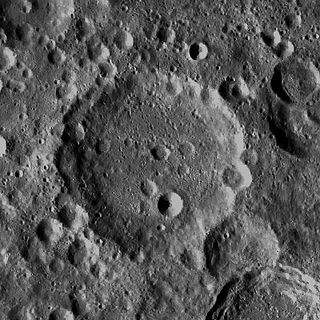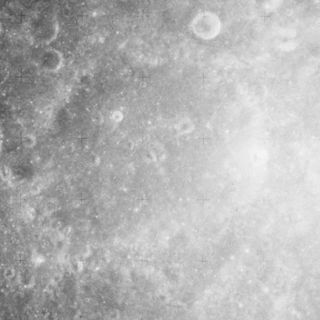
Janssen is an ancient impact crater located in the highland region near the southeastern lunar limb. The entire structure has been heavily worn and is marked by many lesser crater impacts. The outer wall is breached in multiple locations, but the outline of the crater rim can still be observed. The wall forms a distinctive hexagonal shape upon the rugged lunar surface, with a slight curvature at the vertices.

Anderson is a lunar impact crater that is located on the far side of the Moon. It is located to the northwest of the crater Sharonov, and the satellite crater Sharanov X is attached to the southeast rim of Anderson. To the northeast is the peculiar formation Buys-Ballot, and to the east-southeast lies the larger crater Spencer Jones.

Abenezra is a lunar impact crater located in the rugged highlands in the south-central section of the Moon. Abenezra is named after the Sephardic Jewish sage, poet, biblical commentator, astronomer, and astrologer Abraham ibn Ezra, It is attached along the southeast rim to the crater Azophi. To the northeast lies the crater Geber, and further to the southeast is the larger Sacrobosco.

Cavendish is a lunar impact crater that is located in the southwest part of the Moon, to the southwest of the larger crater Mersenius. It lies between the smaller craters Henry to the west-northwest and de Gasparis to the east-southeast.

Doppelmayer is the remains of a lunar impact crater that lies on the southwest edge of Mare Humorum. It was named after the German mathematician and astronomer Johann Gabriel Doppelmayr. To the south-southeast is another flooded crater designated Lee, and to the southeast is Vitello. Just to the east-northeast of Doppelmayer lies the nearly submerged crater Puiseux.

Alekhin is a lunar impact crater that is located on the southern hemisphere on the far side of the Moon. It lies to the north of the crater Zeeman, and south-southeast of Fizeau. To the west lies Crommelin, and east-southeast is Doerfel.

Artem'ev is a lunar impact crater that is located on the far side of the Moon. The rim of this crater has been modified by subsequent impacts in the vicinity, with an inward bulge along the southwest edge and a worn impact lying across the north rim. The satellite crater Artem'ev G is partly overlain by the southeast rim of Artem'ev. The crater interior is relatively flat, and marked only by tiny craterlets.

Brown is a lunar impact crater that is located in the southeast part of the Moon, to the southwest of the prominent ray crater Tycho. Northwest of Brown is the crater Wilhelm, and to the west is Montanari. This crater was named after Ernest William Brown, and is distinct from crater D. Brown, a satellite crater of the Apollo crater.

Bohr is a lunar impact crater that is located near the western lunar limb, in the area that is affected by librations. It is attached to the southwestern rim of the larger, eroded Vasco da Gama formation, and to the southeast of the crater Einstein. The crater was observed for the first time in 1963, by Arthus and Ewen Whitaker in the book Rectified Lunar Atlas.

Chamberlin is a lunar impact crater that is located on the far side of the Moon, just past the southeastern limb. It lies to the southeast of the crater Jeans, and Moulton is attached to the southeastern rim of Chamberlin. This crater is located in a part of the lunar surface that has undergone resurfacing of crater interiors, producing dark-hued crater floors.

Biela is a lunar impact crater that is located in the rugged highlands of the southeastern Moon. It is named after Austrian astronomer Wilhelm von Biela. The crater lies to the east of Rosenberger, to the southeast of the Watt–Steinheil double crater.

Borda is a lunar impact crater that lies between Santbech to the north-northwest and Reichenbach slightly further away to the south-southeast. It was named after French astronomer Jean-Charles de Borda. It has a low rim that is broken along the southeast by a smaller crater. The rim is intruded into by another small crater along the southwest side, and there is an irregular cleft along the northwest face. There is a central peak at the midpoint of the floor.

Berkner is a lunar impact crater that is located on the far side of the Moon, just past the western limb. It is attached to the east-southeast rim of the crater Parenago. Just to the south is the Robertson, and to the southeast is Helberg.

Buisson is a lunar impact crater that is located on the far side of the Moon. It is named after the French physicist Henri Buisson. Nearly attached to the southeast rim is the crater Vesalius. To the southwest is Einthoven. The rim of this crater is somewhat worn, and is lowest in the north. There is a low central ridge across the midpoint.

da Vinci is a lunar impact crater that is located in the eastern part of the Moon, to the northwest of Mare Fecunditatis. It lies along the eastern shore of the Sinus Concordiae, a bay along the eastern edge of Mare Tranquillitatis. Nearby craters include Watts to the southeast and Lawrence to the southwest, both smaller in dimension than da Vinci.

Cook is a lunar impact crater that lies in the western part of the Mare Fecunditatis, just to the southeast of the prominent crater Colombo. To the southwest is Monge.

Chevallier is a lunar impact crater that is located in the northeastern part of the Moon's near side, about a crater diameter east-southeast of the prominent crater Atlas. To the south-southeast of Chevallier is the flooded crater Shuckburgh.

Cockcroft is a lunar impact crater that is situated on the far side of the Moon from the Earth, so that it has only be observed and photographed from orbit. It lies to the northeast of the larger crater Fitzgerald, and southeast of Evershed.

Dziewulski is a lunar impact crater on the far side of the Moon. It lies between the craters Edison to the north and Popov to the south. The outer rim of this crater has been considerably worn by impacts, particularly along the southwest quadrant where the satellite crater Dziewulski Q overlies the rim and the interior floor. The northern rim is also heavily disrupted, and several small crater lie along the southeast rim. The interior floor and surrounding terrain has been resurfaced.

Fersman is a large lunar impact crater on the Moon's far side. It lies to the east of the crater Poynting, and west-northwest of Weyl. To the south is the huge walled plain Hertzsprung.






















